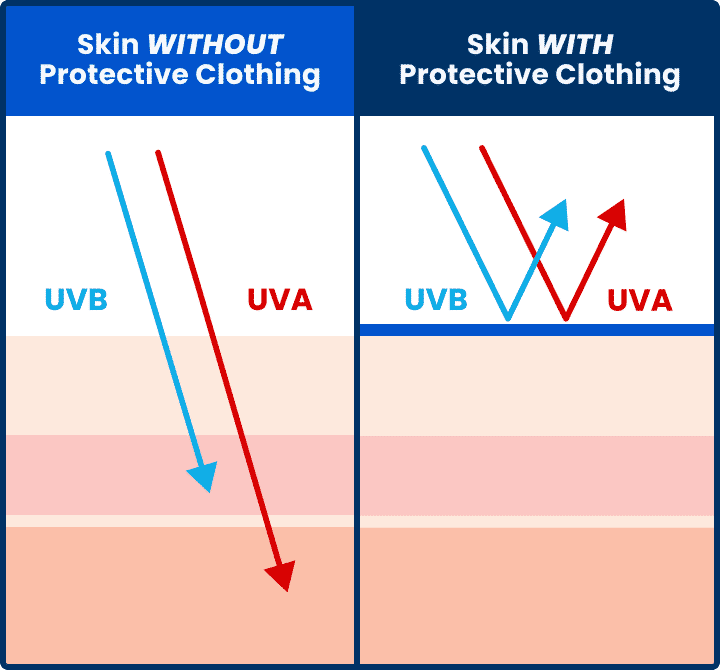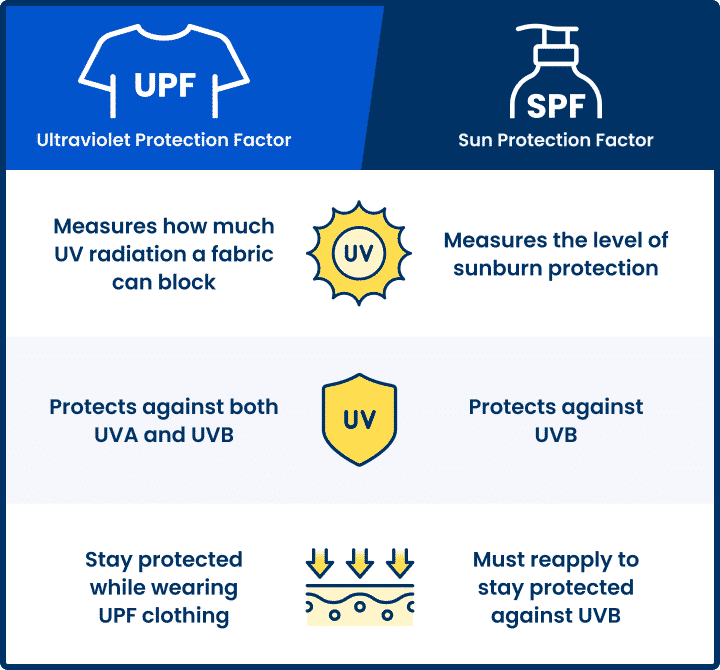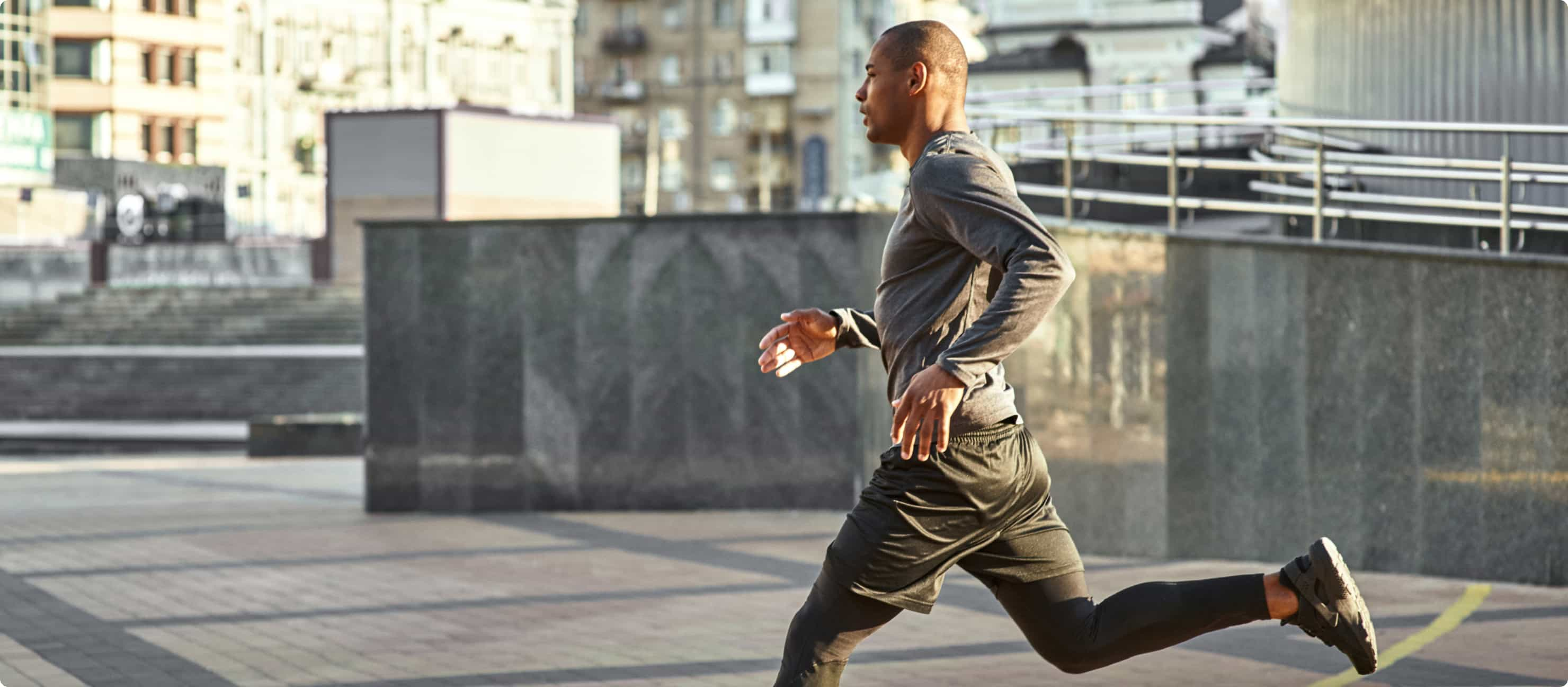UPF Clothing: How To Choose Sun Protective Clothes

Ready for a day of outdoor fun under the sun or planning a hard day’s work outdoors? Whether you’re spending a small afternoon at the park or a full day at the beach, UPF clothing is just as important as sunblock!
But what is UPF clothing? Learn all about these lightweight, breathable, and stylish clothes that help shield you from the sun's rays.
Key Takeaways
-
Discover what UPF clothing is and why it’s regarded as one of the most popular choices for outdoor enthusiasts: gardeners, outdoor workmen, hikers, runners, and more!
-
Learn the difference between UPF vs. SPF and what types of UV light they each protect against.
-
Unpack the top factors to consider when shopping for UPF clothing (like coverage, UPF rating, and more).
-
Uncover how long UPF clothing lasts, how to care for it, and learn when it’s time to purchase new UPF clothing.
-
Find out if you need to wear sunscreen in addition to UPF clothing and whether you need to apply it under your UPF shirt or shorts.
-
Get answers to your frequently asked questions like whether UPF washes out of clothing over time.
What Is UPF Clothing
UPF clothing is specially designed clothing that better protects your skin against the sun’s harmful ultraviolet (UV) rays. ‘UPF’ stands for ultraviolet protection factor. By wearing UPF clothing, you can reduce the risk of sunburn and long-term skin damage.
-
Similar to sunscreen, UPF clothing has a rating — like UPF 25, 50, or 100 — that indicates its level of UV protection.
-
This rating refers to the percentage of UV rays that UPF clothing can block from reaching your skin.
UPF Clothing Ratings
| UPF Clothing Ratings Explained | |||||
|---|---|---|---|---|---|
| UPF Rating | UV Rays Blocked (%) | Protection Category | Effective UV Transmission | ||
| UPF 15-24 | 93.3% - 95.9% | Minimum | 6.7% - 4.1% | ||
| UPF 25-39 | 96.0% - 97.4% | Good | 4.0% - 2.6% | ||
| UPF 40-49 | 97.5% - 98.0% | Very Good | 2.5% - 2.0% | ||
| UPF 50+ | 98.0% - 99.0+% | Excellent | 2.0% - 1.0% (or less) | ||
While all clothes offer some level of UV protection, a UPF rating means the garment is specifically designed for higher protection.
-
UPF only measures UVB and UVA blocking — not other forms of light or radiation.
-
UPF clothing offers various levels of protection: from minimum to excellent coverage.
-
The actual level of protection varies due to factors like the fabric type, stretch, and wetness.
A white cotton t-shirt typically has a UPF rating of 5-7, while a black garment with a UPF rating of 50 allows only 2% of UV radiation to penetrate the fabric — indicating a significantly higher level of protection.
Expert Tip:
Effective UV Transmission is the percentage of UV radiation NOT blocked by the fabric (or how much radiation reaches the skin). Lower transmission percentages signify better sun protection by reducing the amount of UV radiation reaching your skin.
How Does UPF Clothing Work?

UPF clothing works by employing tightly woven or specially treated fabrics to block harmful UV rays.
-
In some cases, UPF clothing is treated with chemical UV absorbers that are absorbed into the fabric rather than simply sitting on top.
-
These measures enhance the clothing's ability to protect against UV radiation.
Is UPF Clothing Necessary?
Yes! UPF clothing is made to keep your skin safe from the sun's harmful rays. These rays can harm your skin and even cause skin cancer. These rays are always there — even when it's cloudy — and can make your skin age faster and possibly lead to skin cancer.
UPF clothes are made from special fabrics that block these bad rays from reaching your skin. Wearing these clothes is a great way to protect yourself from the sun — especially when you're outside a lot like at the beach or playing outdoor sports.
UPF vs SPF: What’s the Difference?

UPF (Ultraviolet Protection Factor) and SPF (Sun Protection Factor) are two different measures of sun protection.
-
UPF is used to evaluate the effectiveness of clothing in blocking both UVA and UVB rays.
-
SPF measures the ability of a sunscreen to block UVB rays, which are responsible for sunburns.
-
While some broad-spectrum sunscreens offer protection against both UVA and UVB rays, many standard sunscreen products focus primarily on UVB protection.
-
You should reapply sunscreen every two hours to maintain its effectiveness, whereas UPF clothing retains its protection unless it becomes wet or the garment fades over time.
What to Consider When Shopping for UPF Clothing
If it’s your first time shopping for UPF clothing, you’ll want to pay attention to the following:
UPF Clothing Coverage

When it comes to UPF clothing, coverage plays a crucial role as any body part left exposed will still require sunscreen.
-
Opt for long-sleeved shirts and pants to provide the most coverage: especially for activities like beach outings.
-
If your UPF clothing gets wet, its effectiveness in blocking the sun's rays may diminish.
UPF Clothing Fit
-
Ideally, the clothing should have a close fit to your body without being too tight or too loose.
-
If the garment stretches, ensure that there are no gaps that could leave you vulnerable to the sun's rays.
-
The garment should have a snug fit but still be comfortable enough so you can move freely.
UPF Clothing Weave
-
A tighter weave provides better UV protection by minimizing the amount of UV radiation that can pass through the fabric.
-
Avoid choosing woven fabrics with big gaps, since these can compromise the garment's ability to block UV rays effectively.
UPF Clothing Material
-
Synthetic materials — like polyester — generally offer better UV protection compared to natural materials (like cotton).
-
Satin is another material that can effectively block UV rays.
Expert Tip:
You can hold the garment up outside and check for transparency. If the fabric is more transparent and allows the sun's rays to pass through, it may not provide adequate sun protection.
UPF Clothing Color

The choice of color can also impact the UV protection provided by UPF clothing.
-
Darker colors tend to be more effective at blocking UV rays compared to lighter colors.
-
Brighter colors can offer good UV protection as well.
-
Steer clear of lighter colors (especially white). They may provide less effective sun protection.
UPF Clothing Rating
-
Choose clothing with a minimum UPF rating of 30. This rating signifies a good level of UV protection.
-
For optimal protection, clothes with a UPF rating of 50+ are the best choice.
UPF Clothing Labels
When shopping for UPF clothing, look for any additional labels that certify the clothing’s effectiveness from UV rays.
-
Look for clothing that bears the Skin Cancer Foundation seal. This seal indicates that the clothing has undergone testing and has a UPF rating of at least 30 — meeting the foundation's standards for effective sun protection.
-
Some companies voluntarily subject their UPF clothing to independent testing at specialized labs: providing further assurance of their UV protectiveness.
Other UPF Clothing Considerations
-
The time of the day: The sun’s rays are strongest from late morning to early afternoon.
-
The season: Spring and summer are the sunniest!
-
Your location: The closer you are to the equator, the hotter it gets.
-
Altitude: The higher your altitude, the more intense the sun’s rays are.
-
Stratospheric ozone: The thickness of these layers affects the level of sun exposure you have.
-
Other factors: Cloud cover, smog, and smoke can also play a role.
Expert Tip:
All these factors can help you decide when and where to rock that UPF-rated outfit. Combine your UPF clothing with some sunscreen and occasional shade breaks for a full-proof plan to enjoy your sunny day worry-free and skin safe.
How Long Does UPF Clothing Last?

UPF clothing is known for its durability, typically lasting for approximately 30 to 50 washes. Over time, as the color fades, the effectiveness of the UPF chemicals may decrease. To prolong the lifespan of UPF clothing, it is recommended to use a gentle wash cycle and opt for air drying rather than using a dryer.
Do You Need to Wear Sunscreen In Addition to UPF Clothing?
Wearing UPF clothing eliminates the need to apply sunscreen underneath the covered areas. The tightly woven or treated fabric of UPF clothing acts as a barrier — blocking harmful UV rays from reaching the skin.
You should still apply sunscreen to any exposed parts of your body (like the neck and face). Using a combination of UPF clothing and sunscreen provides an added layer of defense against the sun's harmful rays: offering optimal protection for your skin!
Frequently Asked Questions
Does UPF Wash Out of Clothing?
Over time, UPF does break down. UPF clothing can become less effective. Consider replacing your UPF clothing when its color fades or after between 30-50 washes.
Is UPF Clothing Better Than SPF?
UPF clothing protects against both UVA and UVB rays, which makes it far superior to sunscreen alone. Sunscreen only protects against UVB rays. Therefore, UPF clothing ensures that your skin is adequately protected from the sun’s damaging rays.

Have Fun Out There!
It’s time to enjoy that nice summer break the best way possible! Academy makes it so easy to enjoy plenty of outdoor activities while protecting your skin’s health.
This time of year typically calls for shorts and other apparel. But don’t write off our collection of men’s and women's rash guards! They'll shield your skin from harmful UVA and UVB rays for those fun days on the beach or the pool.


